-
Product Management
Software Testing
Technology Consulting
-
Multi-Vendor Marketplace
Online StoreCreate an online store with unique design and features at minimal cost using our MarketAge solutionCustom MarketplaceGet a unique, scalable, and cost-effective online marketplace with minimum time to marketTelemedicine SoftwareGet a cost-efficient, HIPAA-compliant telemedicine solution tailored to your facility's requirementsChat AppGet a customizable chat solution to connect users across multiple apps and platformsCustom Booking SystemImprove your business operations and expand to new markets with our appointment booking solutionVideo ConferencingAdjust our video conferencing solution for your business needsFor EnterpriseScale, automate, and improve business processes in your enterprise with our custom software solutionsFor StartupsTurn your startup ideas into viable, value-driven, and commercially successful software solutions -
-
- Case Studies
- Blog
The Best Approaches to Reduce the Cost of Software Product Testing
Testing is an integral part of creating a high-quality software product. However, it may be quite expensive. The Capgemini World Quality Report for 2015–2016 revealed that about 35% of money spent in IT is allocated to quality assurance. Read this article to learn how to reduce testing costs while still getting efficient quality assurance services.
Approaches to reducing the cost of software testing
Although software testing may cost lots of money, you should not neglect it. After all, skipping quality assurance checks may end up costing even more money. In 2017, Software Fail Watch estimated that the world economy could save $1.7 trillion if appropriate quality assurance checks were made before releasing software.
Here, we list the top seven tips for reducing the cost of software project testing to create a high-quality software product at a reasonable price.

#1 Set clear testing goals and requirements
Sometimes, the software testing process may be resource-intensive yet inefficient. To avoid this and make the most of quality assurance checks, the first step experienced teams take before testing is eliciting project requirements and goals. The aim is to ensure that you and your QA team share the same vision for how the testing process should be carried out and the results it should bring.
Your team of quality assurance engineers should agree with you on all testing activities to be done and collect a full list of devices, browsers, platforms, and operating system versions your software product needs to be tested on. This helps to reduce testing costs by giving your team a clear scope of tasks to complete and minimizing the chances that testing will go wrong or require more resources than expected.
To make communication with the testing team more efficient, consider answering the following questions before the testing process starts and sharing your answers with the QA team:

What are your expectations for testing?
It’s crucial to convey what you expect from your testing team and what tasks you want them to complete. The mission of your testing team is to analyze your requirements and figure out the best way to meet them. Besides, you’ll need to specify the main criteria for evaluating the success of the testing process and the time frames within which you want testing to be performed.
What are your testing priorities?
Before starting the testing process, you need to prioritize the components and functionalities of your project that the team should test first. This allows your team to plan testing in accordance with the needs of your project. To have a full understanding of the project specifics, your QA team also needs to know who will be using your product and be aware of the functions that will be used the most. The environment, platforms, and devices used during testing should also be discussed by you and the team of QA engineers.
Based on the information provided, testing engineers will choose the appropriate types of testing for your project, indicate the major risks, and plan the overall testing process.
What deliverables do you expect from your team?
Tell your team the format you want to get bug reports in, the information they should contain, and the way testing results should be presented. Make a list of all reports you want the team to provide: time reports, testing results, and so on.
How will you communicate with the team?
Specify the communication channels you’ll use to get in touch with your external QA team, how often meetings will be conducted, and what issues will be discussed during those meetings.
#2 Start testing as soon as possible
To reduce testing costs, it’s crucial to start testing when you start development. Discovering defects after release may be up to 30 times more expensive than uncovering them in the design and architectural phases.
Here’s how the cost of a defect rises at different stages of the software development life cycle (SDLC) according to IBM.

If you start testing your product at the early stages of the SDLC, you’ll be aware of bugs and defects much earlier, and your development team will be able to start working on them sooner. On the contrary, if you perform testing at later stages when all parts of the project are integrated and testing identifies considerable issues with functionality, your team will need to put much effort into redesigning parts of the product or even reconsider the whole app architecture.
#3 Apply test-driven development
Test-driven development (TDD) is a software development approach that comprises writing unit tests before writing code. TDD starts with writing unit tests for small pieces of functionality. Such tests help to specify what exactly the code should do and keep it clear and straightforward.
Let’s review the main benefits of TDD.
Prevents scope creep
Scope creep refers to an increase in a project’s requirements and uncontrolled growth in the scope of work during the SDLC that results in delivery delays. TDD, if used properly, can help to avoid scope creep.
To apply TDD to your project, you must be sure your developers fully understand the product requirements and how each feature should work. TDD entails writing unit tests that serve as specifications. Thus, when writing code, your developers need a clear understanding of how it should work to pass a test they’ve already created.
Provides a maintainable codebase
TDD aims at improving code readability and creating a robust product architecture that simplifies the process of adding new features or modifying existing code. Adherence to TDD principles makes it easier for others to modify, maintain, and test your code.
Helps developers prevent bugs
The main principle of TDD is to prevent bugs rather than detect and remove them after the code is ready. Moreover, while using TDD during development, developers write a huge number of unit tests. This helps to provide a high percentage of test coverage, identify potential issues before the product is at the final development stage, and improve the software quality.
Reduces development costs
Adopting TDD pays off in the form of better quality code, a flexible architecture, and fewer bugs. If followed strictly, TDD allows for providing 100% test coverage and fixing bugs gradually during development rather than doing it after the whole application is ready. Thus, with TDD, your product will have fewer bugs and require less time for testing and bug fixes than if you’d used a conventional coding method.
With TDD, unit tests are created by developers themselves. For this reason, at the end of the development process, you’ll receive software with a clearer architecture and fewer bugs compared to software developed without TDD. It should also require considerably less effort from your quality assurance team to identify major risks in such software (which should need only minor fixes), helping to significantly reduce testing costs.
#4 Automate more
Time is money, and test automation allows your team to save both. Automation allows your team to write a test once and then run it unlimited times without human intervention. Not every test can be automated. But the task of your team is to automate and save time on as many tests as possible.
Besides saving your time and money, automation has the following advantages.
Improved efficiency
Test automation allows you to run tests automatically, sparing time for more complicated testing tasks and helping you cut down on the time required for testing iterations. Thus, QA engineers manage to deliver bug reports faster and your developers can start working on bug fixes sooner.
Reusability
Automation testing tools allow you to configure test cases and test suites that can be used throughout different stages of testing. This makes the testing engineers’ workflow easier and more comfortable.
Greater test coverage
Automating more tests allows you to run more test suites and provide a higher level of test coverage by the end of the testing process. Test coverage is one of the most crucial points in assessing the quality of testing and detecting a majority of project issues. High-quality testing requires 80% to 100% test coverage.
Although implementing automation testing techniques may seem a bit complicated, the benefits they bring to your team’s workflow are worth all the efforts.
#5 Implement a risk-based testing approach
Risk-based testing implies conducting a testing process in accordance with the risks that may appear with a tested project.
Here’s how risk-based testing is performed:
Create a prioritized list of risks
As the SDLC starts, the risk-based testing approach allows QA engineers to identify and prioritize risks that may influence the quality of the product. This simplifies test planning and preparation.
Conduct testing to explore the greatest risks
Risk-based testing implies testing functionalities that have the biggest influence on overall product performance and have the highest probability of failure. This helps you identify the most harmful issues, such as information leakages, security gaps, and performance problems that are critical for your business.
Adjust the testing strategy
After known risks are eliminated by your development team, the whole cycle should be repeated several times to assign testing priorities and detect the majority of issues.
Risk-based testing aims to effectively analyze critical issues your software product is prone to and plan the software testing process in a way that will be most productive for identifying these issues.
#6 Mind the hidden costs
When planning a budget for your project, take into consideration indirect expenses that may occur during the testing process:
Learning and adoption expenses
If your software product has unique or hard to test functionalities, your testing engineers will need more time to get acquainted with it and test it appropriately. Moreover, QA teams may need to master specific testing tools to check all areas of your software product, which also entails hidden costs.
Infrastructure expenses
When choosing a tool for testing your software project, pay attention to its infrastructure. Both licensed and open-source automation tools may entail additional costs related to servers, databases, or cloud services.
Maintenance expenses
Updates are made over time to introduce changes to testing tools, bring new features, and make use of the latest technologies. However, such updates may lead to issues with existing code. Thus, to use code that was created before the tool was updated, your QA engineers may require additional time for reworking it.
Such indirect expenses should not be neglected, as they may take a considerable part of your project budget. Devote enough time to thorough analysis of possible hidden costs and choose tools that entail fewer indirect expenses to significantly reduce testing costs.
#7 Outsource testing tasks
Outsourcing helps you avoid expenses on infrastructure and HR services. Moreover, you can choose a team in a country with lower hourly rates compared to those in the United States with no loss of quality.
According to Clutch, rates for software testing services in the US and Western Europe can vary from $50 to $150 per hour. In Eastern Europe, the same testing services will cost you from $25 to $49 an hour, whereas quality assurance engineers in India and some Asian countries may charge less than $25 per hour.
Summing up
By efficiently organizing your testing process, hiring an experienced team of quality assurance engineers, and preparing properly, you can reduce testing costs without compromising quality.
FAQ
-
Here are 7 strategies to reduce the cost of QA services:
- Set clear testing goals and requirements
- Start testing as soon as possible
- Apply test-driven development (TDD)
- Automate more
- Implement a risk-based testing approach
- Mind the hidden costs
- Outsource testing tasks
-
Most of the hidden costs of software testing are related to automation tools and include expenses for:
- Learning and adoption
- Infrastructure
- Maintenance
-
The best way to get quality service at a reasonable cost is to outsource testing tasks. If you’re looking for a reliable team of highly skilled QA engineers to test your product, contact the RubyGarage team and tell us about your needs.










